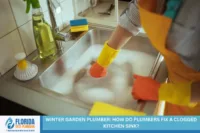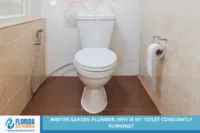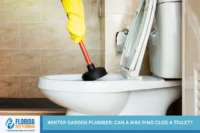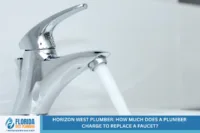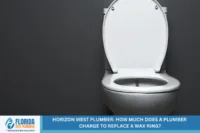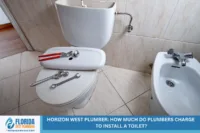Toilets are essential fixtures that contribute to the daily comfort and hygiene of your home. Understanding when to replace your toilet is crucial, and consulting with a plumber can help prevent inconvenience and avoid costly future repairs. Whether you’re dealing with a toilet that’s outdated, inefficient, or prone to frequent issues, knowing when to replace it can save you both time and money. For homeowners in Horizon West, Florida, this decision becomes even more crucial due to the local climate and water conditions, which can impact the longevity of plumbing systems. In this article, we will explore the signs that indicate a toilet replacement is necessary, factors that affect the lifespan of toilets, and expert advice to help you make an informed decision for your home and budget.
The Lifespan of Toilets and What Affects It
The average lifespan of a toilet typically ranges from 10 to 15 years; however, the durability and efficiency of your toilet can be influenced by several factors. Understanding these factors helps homeowners determine when a toilet may need to be replaced.
1. Age of the Toilet
One of the primary factors determining whether it’s time to replace a toilet is its age. Toilets manufactured before the 1990s were generally less efficient in water usage, using up to 7 gallons per flush. Today’s modern toilets are designed to use far less water, typically around 1.6 gallons per flush. In Horizon West, Florida, where water conservation is a growing concern, replacing an old toilet with a newer, more water-efficient model can not only save you money on your water bill but also contribute to environmental sustainability.
2. Environmental Impact and Water Usage
Old toilets, especially those installed before the WaterSense guidelines came into effect, tend to waste more water. In areas like Horizon West, which is part of the larger Orlando metropolitan area, conserving water is a priority. By upgrading to a newer, more water-efficient toilet, you can reduce your water consumption and support your community’s efforts to conserve local water resources.
3. Quality of Materials and Local Water Conditions
The quality of the materials used in the construction of the toilet also plays a role in its longevity. For example, porcelain toilets, the most common type, are more likely to withstand wear and tear than those made from other materials. However, the condition of local water can significantly impact the toilet’s performance. In Horizon West, the water can sometimes be high in minerals, which can lead to rust or mineral buildup inside the toilet. This can degrade the toilet’s performance over time.
Key Indicators That It’s Time to Replace Your Toilet
Replacing your toilet is an investment that can save you from bigger headaches in the future. There are a few clear signs that indicate it’s time for a replacement rather than just a repair.
1. Visible Cracks in the Toilet Bowl or Tank
One of the most alarming signs that a toilet needs to be replaced is the appearance of cracks in the bowl or tank. Even minor cracks can compromise the structural integrity of your toilet, leading to potential leaks or water damage. Cracks can occur for various reasons, including age, physical damage, or fluctuations in high-pressure water. If you notice cracks, it’s best to replace the toilet as soon as possible to avoid any further damage.
2. Frequent Clogs or Weak Flushing
Another strong indication that you should consider replacing your toilet is if it frequently clogs or if it fails to flush properly. A toilet that requires multiple flushes to remove waste or one that clogs easily could be suffering from internal mechanical failure. While you can often temporarily repair a clogged toilet, frequent problems with flushing are usually a sign that the toilet is no longer functioning optimally and may need to be replaced.
3. Water Leaks Around the Toilet Base
Water leaks around the base of the toilet can occur due to a damaged wax seal or other internal issues. While a leaking toilet may seem like a minor issue at first, persistent leaks can cause water damage to the surrounding floor and potentially lead to the growth of mold and mildew. If your toilet is leaking regularly, it might be a sign that it’s time for a replacement, especially if the leak persists even after repairs.
The Cost of Toilet Replacement
Replacing a toilet involves both the cost of the unit itself and the cost of professional installation. Here are the main cost factors to consider:
1. Cost of the Toilet Unit
Toilets come in various price ranges, from basic models to high-end options that feature advanced flushing systems or water-saving technologies. The basic model typically costs less, while more advanced models, such as dual-flush or smart toilets, can increase the overall price. Homeowners in Horizon West may also consider purchasing toilets that meet local water efficiency standards.
2. Installation Costs
The cost of installation will depend on whether you are replacing an existing toilet or installing a new one in a different location. Replacing an old toilet with a similar model is generally more affordable than installing a new system that requires additional plumbing adjustments. Hiring a professional plumber in Horizon West ensures that the installation is done correctly and efficiently.
3. Long-Term Savings
While replacing a toilet may seem like a significant upfront cost, the long-term savings often outweigh the initial expense. Toilets that use less water per flush can help reduce water bills over time, especially in a community like Horizon West, where water conservation is emphasized. Additionally, replacing a problematic toilet can prevent further issues that may lead to higher repair costs in the future.
How to Choose the Right Toilet for Your Home
Selecting the right toilet for your home is important for both comfort and functionality. Here are some factors to consider when choosing a new toilet:
1. Water Efficiency and Sustainability
As mentioned earlier, water conservation is a key consideration in Horizon West. Opting for a toilet that meets water-saving standards, such as the WaterSense certification, ensures that your new toilet is both eco-friendly and cost-effective. These toilets use significantly less water per flush, which not only helps preserve water but also lowers your utility bills.
2. Toilet Size and Design
Toilets come in a variety of sizes and designs, so it’s important to choose one that fits well in your bathroom space. Some models are more compact, while others are designed to provide additional comfort. In terms of design, you can choose between a one-piece or two-piece toilet, depending on your preference for aesthetics and ease of cleaning.
3. Toilet Height
The height of the toilet is another factor to consider. Standard toilets are typically around 15 inches tall, but people with mobility issues often prefer comfort-height toilets, as they are around 17-19 inches high. Choosing the right height for your needs ensures that the toilet is comfortable for all family members to use.
Why Replacing Your Toilet Can Be a Wise Decision
Replacing your toilet can significantly improve the efficiency and comfort of your bathroom. With modern technology and water-saving features, a new toilet can save you money on water bills, reduce maintenance costs, and provide a more pleasant bathroom experience. While the decision to replace your toilet may require an upfront investment, the long-term benefits often outweigh the costs.
A toilet that is showing signs of wear and tear, whether due to cracks, leaks, or inefficiency, should be replaced sooner rather than later. A new toilet provides a fresh start for your bathroom, improves water efficiency, and offers peace of mind knowing that you have a reliable, durable system in place.
Horizon West Plumber – Florida’s Best Plumbing
Looking for a trusted plumber in Horizon West, Florida? Florida Best Plumbing LLC is here to help with all your plumbing needs. From minor repairs to complete installations, our experienced team provides a comprehensive range of services to keep your plumbing system in optimal condition. We’re also available 24/7 for emergency plumbing services, so you never have to worry about being left without assistance.
Whether it’s toilet repairs, water heater installations, drain cleaning, or whole-house repiping, we handle it all. For reliable plumbing solutions at competitive prices, contact us today at (407) 683-6644!
FAQ: Toilet Replacement and Repair in Horizon West, Florida
1. How Do I Know If I Need Toilet Repair?
Toilet repair issues can arise from various factors, and several warning signs should be monitored. A wobbly toilet is one of the most common signs that something is wrong. If your toilet is unstable or feels loose, it may be a sign that the tank-to-bowl rubber gaskets or seat bolts need adjustment. Another clear indication is when you notice water pooling around the base, which suggests a leak that could result in mold growth if left unchecked. Additionally, a running toilet is often caused by a malfunctioning fill valve, flapper valve, or flush valve. If your flush performance is weak or if the flush handle is unresponsive, the problem may lie with internal components. It’s always best to contact a professional plumber to accurately diagnose and fix these issues before they lead to more costly repairs.
2. What Are the Common Causes of a Running Toilet?
A running toilet is one of the most frustrating plumbing issues homeowners face. Several factors can contribute to this problem, including faulty components like the fill valve, flush valve, or flapper valve. When the flush valve doesn’t seal properly, water continues to run into the toilet tank, causing the toilet to run continuously. Another common cause is a crack in your toilet bowl or hairline cracks in the toilet tank, which may let water escape, resulting in a never-ending cycle of refilling. Water waste is also a big concern here, as it can lead to higher water bills. If you notice the water level in the tank is too high, or if water is constantly trickling into the bowl, it may be time to replace the faulty valve components. A professional plumber can assess the situation, repair the issues, and help prevent further water waste.
3. How Can I Prevent Mold Growth Around My Toilet?
Mold growth around your toilet can be a significant problem, particularly in areas with high humidity, such as Horizon West, Florida. Water pooling around the base of the toilet is one of the leading causes of mold growth. If you notice moisture accumulation, especially around the toilet rim or overflow pipe, it could be an indication of a leak that requires immediate attention. Low-flush toilets can sometimes result in incomplete flushing, leaving waste behind, which can contribute to the development of mold. Ensure that your flush performance is strong enough to clear waste completely. Another preventive measure is to inspect the flush handle and toilet tank for leaks on a regular basis. It’s also important to check the tank-to-bowl rubber gaskets, as damaged seals can allow water to escape and create a breeding ground for mold. A professional plumber can help maintain your toilet and prevent mold buildup.
4. What Are the Benefits of a Low-Flush Toilet?
A low-flush toilet is an excellent choice for homeowners looking to reduce water waste and conserve resources. Modern low-flush toilets use significantly less water per flush compared to older models, typically around 1.28 gallons per flush, which is far more efficient than the 3.5 to 7 gallons used by older toilets. By reducing water waste, these toilets help lower utility bills and contribute to water conservation efforts in areas like Horizon West, Florida. Additionally, low-flush toilets can provide excellent flush performance, ensuring that waste is removed effectively with minimal water usage. Although some models may require higher water pressure for optimal flushing, newer technologies have improved efficiency, making them a smart and eco-friendly option. If you’re upgrading your toilet, consider the added benefits of a low-flush model to save both water and money.
5. Why Is My Toilet Wobbly and How Do I Fix It?
A wobbly toilet can be both annoying and a potential source of damage if not addressed promptly. A toilet that rocks or shifts is usually due to loose seat bolts or an issue with the floor flange. Over time, the tank-to-bowl rubber gaskets can deteriorate, leading to instability. The floor around the toilet may also be uneven, causing the toilet to wobble. In some cases, a crack in your toilet bowl or hairline cracks can also cause movement. To resolve the issue, inspect for any loose bolts and tighten them securely. If the problem persists, a professional plumber may need to inspect the toilet’s installation to ensure everything is securely fastened. Failing to fix a wobbly toilet can lead to leaks, water pooling around the base, and further repair issues down the line. Don’t hesitate to contact a plumber to resolve this problem quickly.
Read more: How Homeowners Can Save on Minor Plumbing Repairs in Horizon West, FL
Winter Garden Plumber: How Do Plumbers Fix a Clogged Kitchen Sink?
If you need a plumber in Winter [...]
Winter Garden Plumber: Why is My Toilet Constantly Running?
Is your first instinct to call a [...]
Winter Garden Plumber: Can a Wax Ring Clog a Toilet?
If you’ve ever dealt with a clogged [...]
Horizon West Plumber: How Much Does a Plumber Charge to Replace a Faucet?
Are you frustrated by leaky faucets, a [...]
Horizon West Plumber: How Much Does a Plumber Charge to Replace a Wax Ring?
If you’ve ever noticed water pooling around [...]
Horizon West Plumber: How Much Do Plumbers Charge to Install a Toilet?
Are you feeling overwhelmed trying to find [...]


